In today’s fiercely competitive job market, traditional recruitment methods may not be enough to attract top talent. Enter social media – a game-changing tool that’s revolutionizing the recruitment landscape.
Did you know that 90% of recruiters report hiring someone from LinkedIn? That’s the power of social media recruiting; it offers a host of advantages, such as broader reach, cost-effectiveness, and real-time engagement!
In this guide, we’ll dive into the world of social media recruiting and provide valuable insights to help you excel in 2024. Discover the potential of harnessing social media platforms to find and engage with top candidates, effectively expanding your talent pool.
Stay ahead of the trends by embracing the power of social media recruitment, capitalizing on its ability to connect with candidates in real-time, and gaining a competitive edge in today’s dynamic job market.
What Is Social Media Recruiting?
Social media recruiting is the process of attracting, engaging, and hiring potential candidates through social media channels. It involves leveraging the power of various social media channels, such as LinkedIn, Facebook, Twitter, Instagram, and emerging platforms, to build relationships with candidates, showcase company culture, and advertise job openings.
But how does it work, and why is it so important? Let’s find out.
Why Is Social Media Important for Recruiting?
Social media is more than just a platform for sharing memes and cat videos. It’s a powerful tool that can help you reach a wider audience, engage with potential candidates, and even save money on recruitment costs. Here’s why:
1. Reach
Social media platforms have billions of active users, providing an unparalleled reach to potential candidates. By utilizing these platforms, recruiters can access a vast pool of talent and increase the visibility of job opportunities.
Take Facebook, for example; with over 2.95 billion active users monthly, it provides an exceptional opportunity for recruiters to tap into a diverse, highly talented pool. This pool includes individuals from different backgrounds, professions, and locations, thereby increasing the chances of finding suitable candidates for specific roles.
Take this example below; a simple hiring post listing the benefits garnered a ton of likes, comments, and shares.
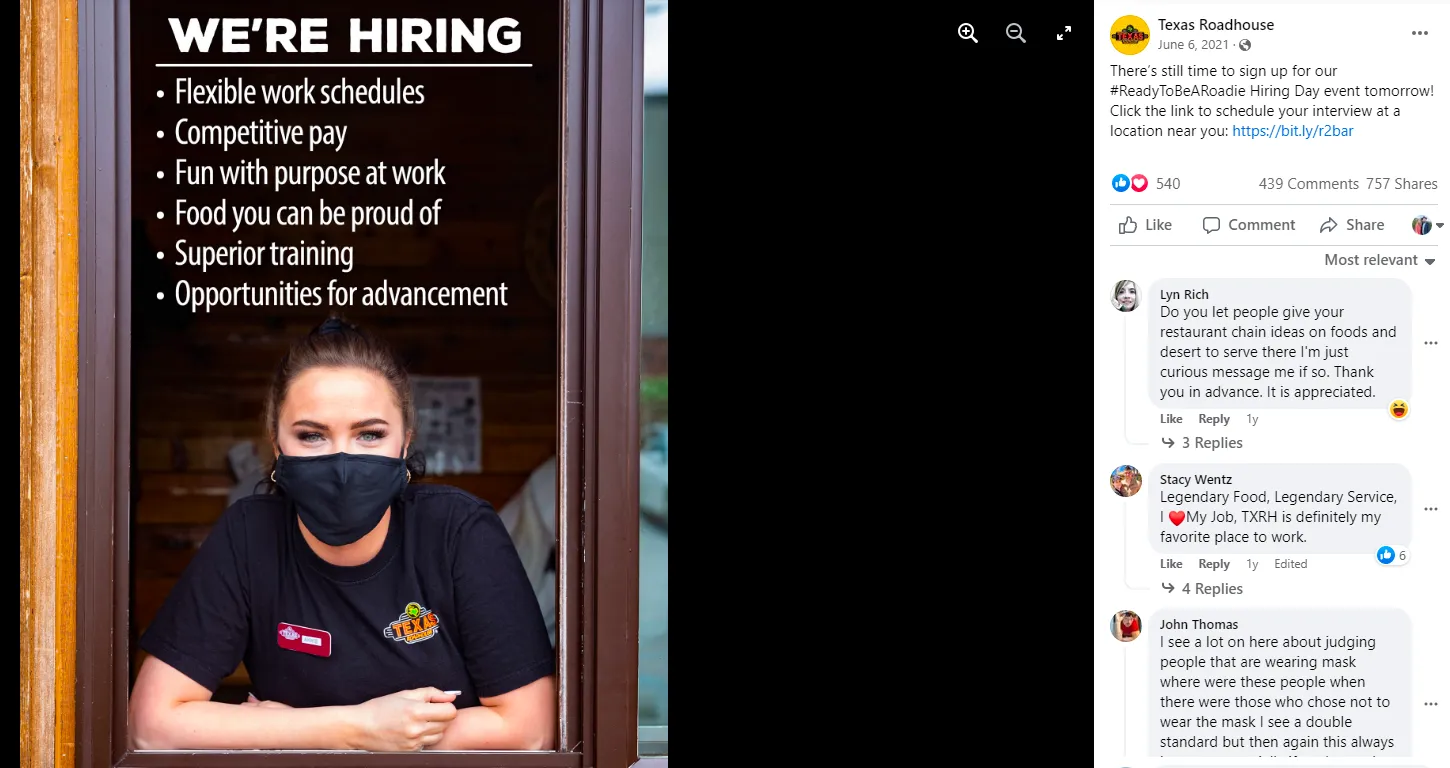
But that’s not all. Social media recruiting also offers cost-effective solutions, as we’ll see next.
2. Cost-Effective
Social media recruiting is often more cost-effective than traditional recruitment methods. Posting job ads, sharing content, and engaging with candidates on social media platforms are generally more affordable than other advertising channels.
This affordability allows recruiters to allocate their recruitment budget more efficiently and maximize their reach compared to traditional methods like print advertising or job boards.
3. Speed
Social media allows for quick and efficient communication with candidates. Recruiters can instantly connect with potential hires, schedule interviews, and expedite the hiring process, reducing time-to-fill vacancies.
Recruiters can also engage with candidates directly through comments, private messages, or live chat features. This instant communication streamlines the hiring process by enabling recruiters to answer candidate questions promptly, schedule interviews, and gather additional information efficiently.
As a result, the back-and-forth communication that usually occurs via email or phone is expedited, reducing the time needed for each tedious step in the recruitment process.
4. Insights
Social media platforms offer valuable insights and analytics to help recruiters understand candidate behavior, preferences, and engagement patterns. This data can inform recruitment strategies and optimize future hiring efforts.
People often share a wide range of content on their social media profiles, including personal updates, hobbies, interests, and opinions.
By reviewing candidates’ posts and content, recruiters can gain insights into their personalities, values, and communication style. For example, posts about community involvement may indicate a candidate’s passion for social causes, while posts showcasing creative projects may suggest their interests and skills in a specific field.
This information can help recruiters assess a candidate’s cultural fit within an organization and determine their potential alignment with company values.
And guess what? Social media can also help enhance your brand. Let’s see how.
5. Brand Promotion
Companies can enhance their employer brand by actively participating in social media recruiting. Consistently sharing compelling content, showcasing company culture, and engaging with candidates can help attract top talent and position the organization as an employer of choice.
By sharing posts, images, videos, and live streaming behind the scenes, companies can give potential candidates an insider’s view of their culture, values, and day-to-day work environment.
6. Real-Time Engagement
Social media allows recruiters to engage with candidates in real-time, creating immediate interaction and building relationships. This dynamic engagement can lead to more personalized and meaningful interactions with potential hires.
Through instant responses to queries, timely updates on job postings, interactive application processes, showcasing company culture in real-time, virtual recruitment events, personalized outreach, and feedback mechanisms, social media enhance the efficiency and personalization of the hiring process.
This real-time interaction fosters engagement, builds relationships, and creates a positive candidate experience.
Now that we’ve covered why social media is important for recruiting let’s move on to why companies should consider social media recruiting.
Why Should Companies Consider Social Media Recruiting?
In the digital age, social media recruiting is no longer optional; it’s a necessity. But why is it so crucial? Let’s find out.
1. Candidate Expectations
Nowadays, candidates aren’t just looking for jobs – they’re looking for experiences. They expect companies to have a solid online presence, including a compelling presence on social media. By embracing social media recruiting, companies can meet these expectations and engage with potential hires on platforms they already use and trust.
Moreover, with the rise of remote work and digital nomadism, job seekers increasingly use their mobile devices for job hunting. Social media platforms are easily accessible via mobile devices, making them convenient for job seekers to browse job postings anytime, anywhere.
This aligns with the expectations of today’s job seekers, who prioritize efficiency and flexibility in their job search.
But meeting candidate expectations is just the tip of the iceberg. Let’s dive into the next reason.
2. Passive Candidates
In the competitive job market, the best talent isn’t always actively looking for a job. These passive candidates are often happily employed and not actively seeking new opportunities – but that doesn’t mean they’re not open to them.
Social media allows recruiters to reach and attract these passive candidates by showcasing enticing content and opportunities that can pique their interest.
Social media platforms enable recruiters to search for and discover potential candidates proactively. Recruiters can use advanced search features, keywords, hashtags, and industry-specific groups to identify professionals with relevant skills and experience.
By engaging with their content or reaching out directly, recruiters can initiate conversations and build relationships with passive candidates who may have yet to come across the job opportunity.
3. Diversity
Diversity and inclusion are not just buzzwords – they’re business imperatives. Social media provides many different platforms to reach a diverse talent pool, engage with underrepresented groups, and promote a company culture that values and shows pride in diversity.
Social Media hosts various groups, communities, and networks focused on specific industries, interests, or diversity initiatives. Companies can engage with these communities by actively participating in discussions, sharing valuable content, and offering insights.
By establishing a presence and engaging with diverse communities, companies can build relationships and attract candidates who are active participants in these spaces.
4. Competitive Advantage
Every advantage counts – and social media recruiting provides several. With social media recruiting, companies can:
- Expand candidate reach
- Enhance employer branding
- Enable direct engagement and relationship building
- Facilitate active sourcing and passive candidate reach
- Offer real-time insights and market intelligence
- Enable data-driven recruitment strategies, and
- Provide an agile and cost-effective recruitment approach.
By leveraging social media effectively, companies can attract top talent, stand out from competitors, and optimize their recruitment processes. This competitive advantage can be the difference between finding the perfect candidate and losing them to a competitor.
But the advantages don’t stop there. There’s one more reason companies should consider social media recruiting, and that is.
5. Targeted Advertising
Advertising is no longer a one-size-fits-all approach – especially when it comes to recruitment. Social media platforms enable highly targeted advertising by leveraging extensive user data, allowing for
- Custom audience creation
- Targeting lookalike audiences
- Interest-based targeting
- Geographic targeting
- Ad scheduling
- Frequency capping, and
- Performance tracking
By utilizing these features, companies can ensure that their job ads reach the suitable candidates who are most likely to be interested and qualified for the advertised positions. This leads to more effective and efficient recruitment campaigns, saving time and resources, and ensuring that the right people see the right job postings at the right time.
Knowing why companies should consider social media recruiting is only half the battle – next, we’ll explore some best practices for social media recruiting to help you get started on the right foot.
6 Best Practices for Social Media Recruiting
Social media recruiting is a powerful tool, but it’s important to use it effectively. Here are some best practices to help you get the most out of your social media recruiting efforts:
1. Use Video Content
Video content is a highly engaging and shareable format. You can create compelling recruitment videos highlighting company culture, employee testimonials, and job descriptions to attract and engage potential candidates.
Video content is also known to improve information retention compared to text-based content. Viewers are more likely to remember the content of a video, making it an effective medium for delivering complex information, product demonstrations, tutorials, or training materials.
Salesforce, a global leader in CRM, exemplifies this approach by using video content on LinkedIn to provide insights into their work environment and share employee testimonials.
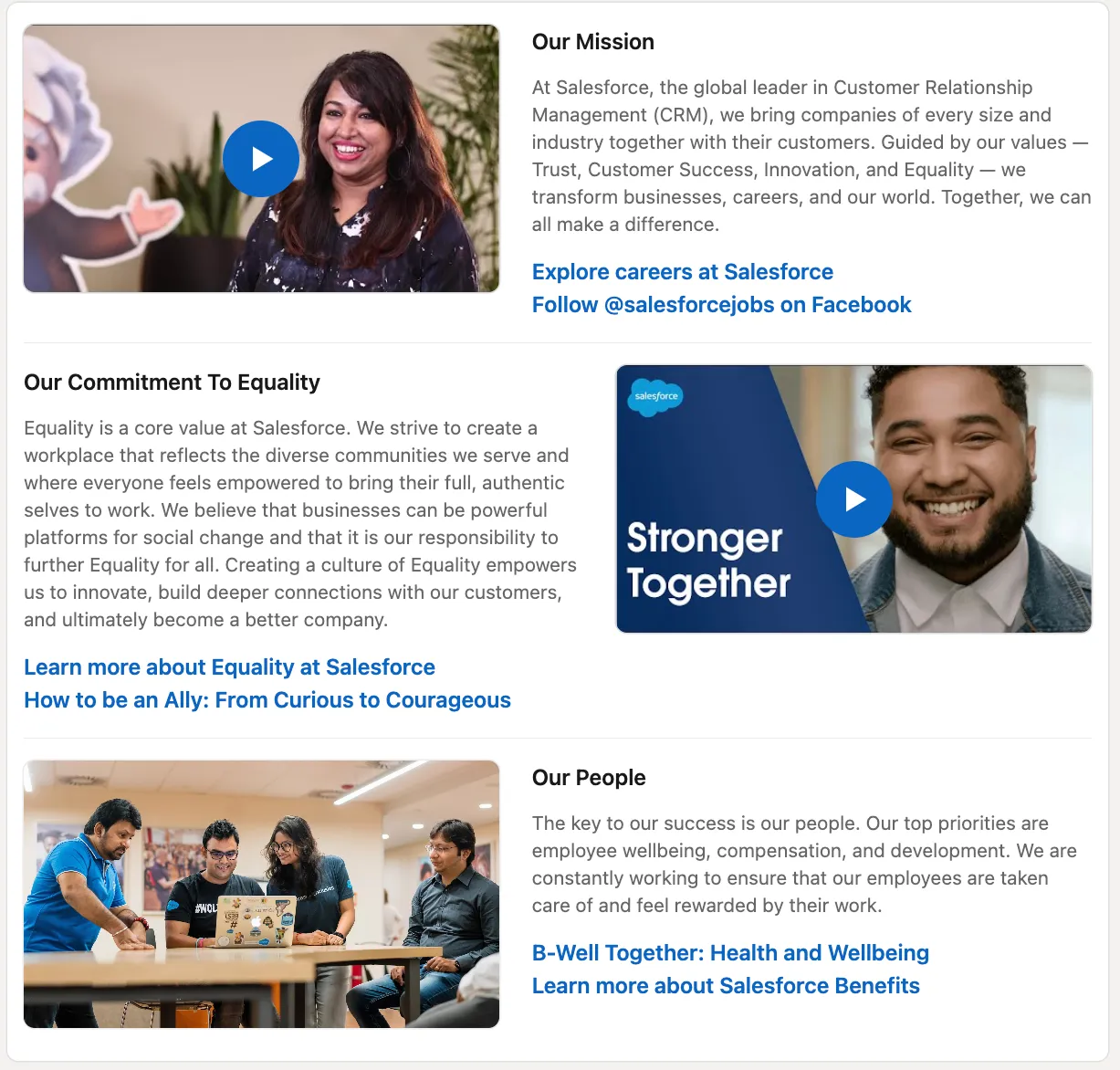
These videos offer a transparent view of the company’s culture, values, and what it’s like to work there, helping potential candidates visualize themselves in those roles.
2. Utilize LinkedIn Recruiter Features
LinkedIn is a go-to platform for professional networking and social media recruitment. Take advantage of LinkedIn Recruiter, for instance. The tool’s features, such as advanced search filters, InMail messaging, and talent pipelining, tremendously streamline the recruitment process.
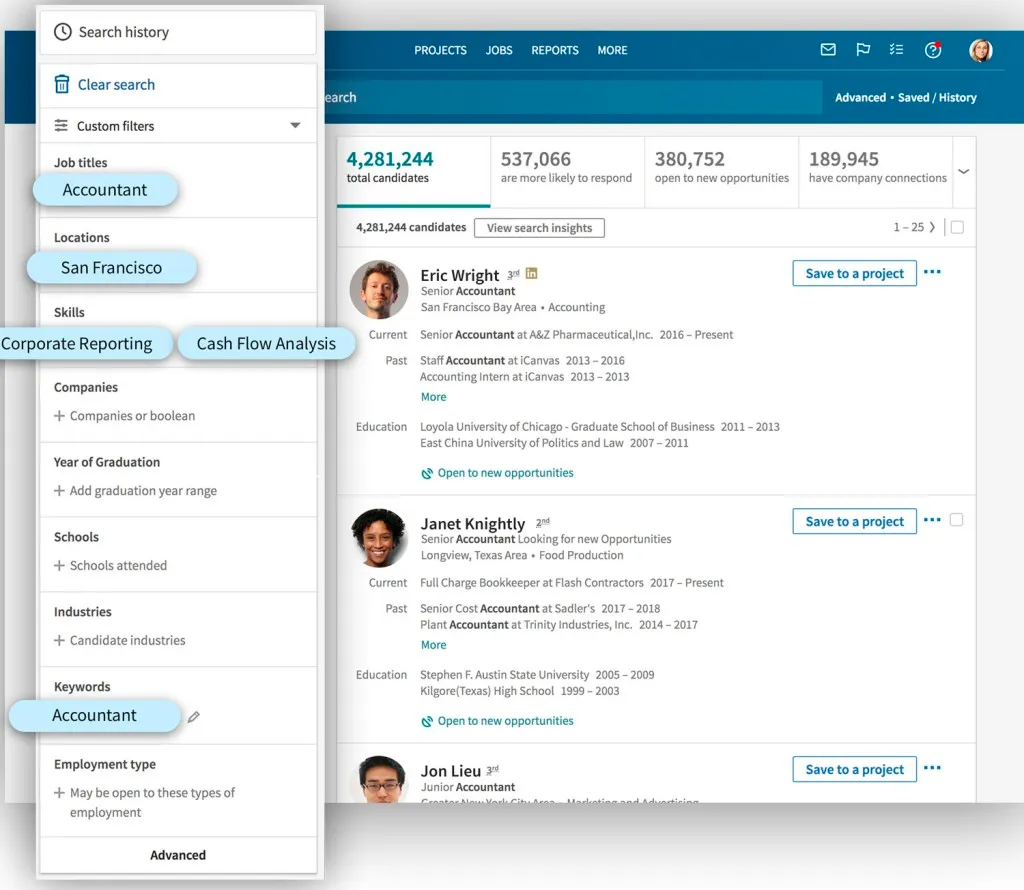
InMail messaging, in particular, eliminates the barriers and limitations often associated with cold outreach. Unlike emails or phone calls that can quickly go unnoticed or ignored, InMail messages are sent directly to a user’s LinkedIn inbox, capturing their attention in a professional context where they are more likely to engage.
The Recruiter platform also provides additional features like talent pool analysis, competitive insights, and integrated hiring processes, making it a must-have tool for social media recruiting.
3. Promote Employee Advocacy
Your employees can be your best advocates. Encouraging them to share your posts, talk about your company culture, and refer their network to your open positions can significantly amplify your reach.
Employee advocacy can significantly expand the reach of your recruitment efforts and enhance your employer brand!
Adobe, for instance, has a strong employee advocacy program, with employees regularly sharing their work experiences. To promote employee advocacy, provide your employees with easy-to-share content and consider implementing a referral program that rewards employees for bringing in successful new hires.
4. Use Job-Specific Hashtags
Hashtags are a powerful tool for increasing the visibility of your job postings. You can research industry-specific and job-specific hashtags to reach a targeted audience and attract candidates actively searching for relevant opportunities.
By including relevant hashtags, recruiters can significantly increase the visibility of their posts.
Why?
Hashtags act as keywords that categorize and organize posts, making it easier for users to discover specific topics or conversations.
When recruiters use popular and relevant hashtags related to their industry, job openings, or particular skills, they broaden the reach of their job posts to a larger audience who may be interested in those specific topics.
Below is a perfect example illustrating a company utilizing hashtags to broaden its reach for a job posting.
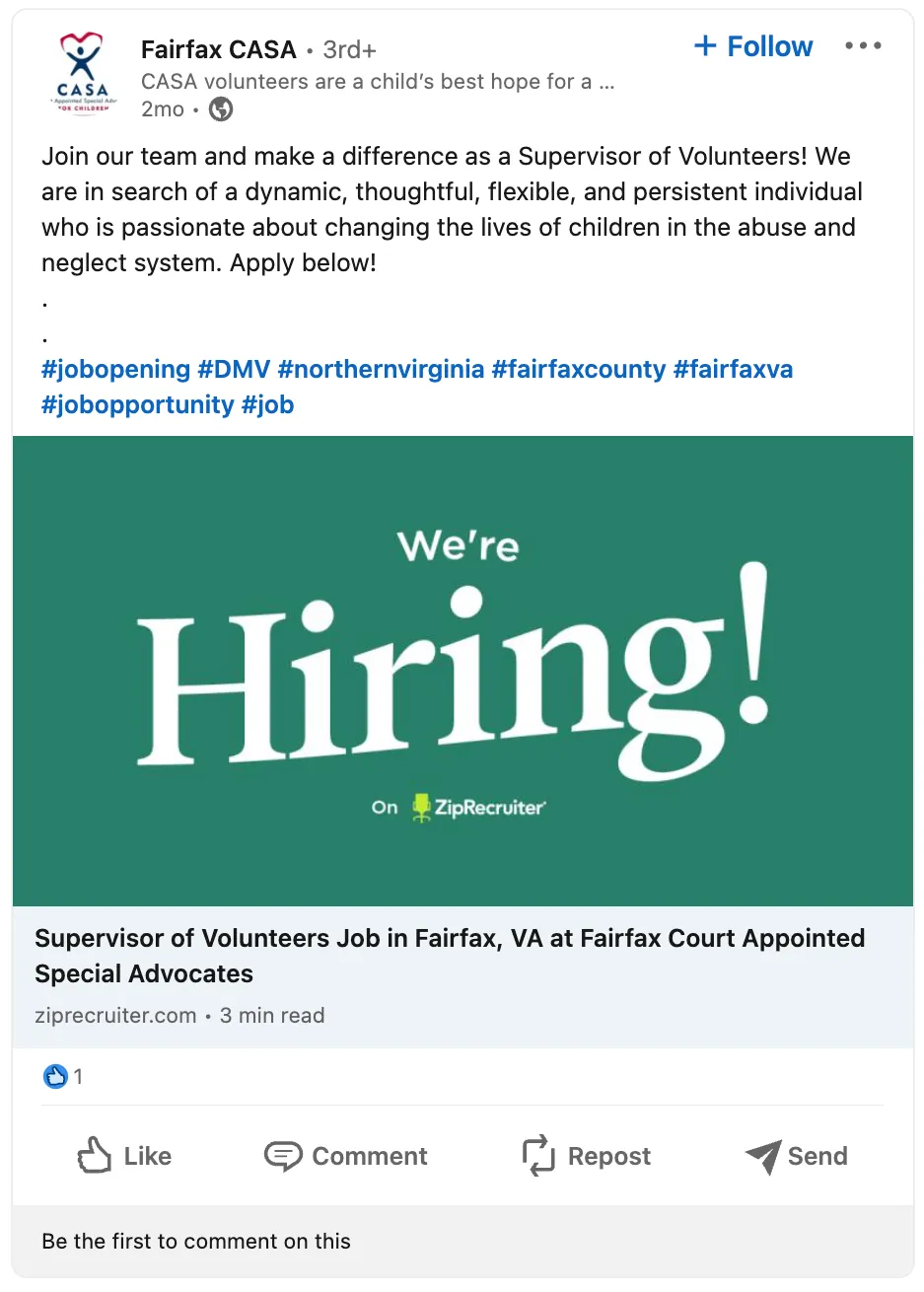
Leverage the power of SocialPilot’s Content Library to streamline your social media recruiting. This feature allows you to store and organize your job-specific hashtags all in one place.
By having a well-organized content library, you can ensure consistency across all your job postings and social media platforms. Plus, it makes it easy for your team to access and use the right content at the right time.
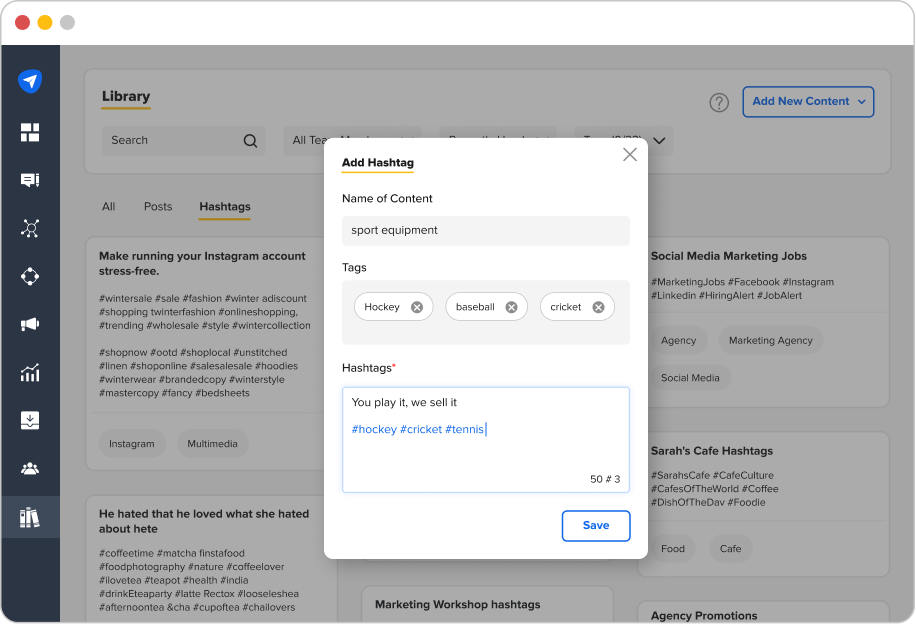
5. Leverage Employee Networks
Your employees’ social networks can be a gold mine for potential candidates. Encourage your employees to share job openings within their networks. LinkedIn, for example, allows employees to share job postings directly from your company page to their network.
To effectively leverage employees’ social networks for recruitment, organizations should create a supportive culture that encourages and incentivizes employees to share job opportunities and positive experiences. Providing clear guidelines, training, and tools for employees to amplify their reach and engage their networks can further enhance the success of this recruitment strategy.
6. Optimize for Mobile
With the increasing use of mobile devices for job searching, ensuring your job postings and application processes are mobile-friendly is crucial. Optimize your job postings, career pages, and application process for mobile devices to provide a seamless experience for candidates.
By offering mobile-friendly job postings and application processes, organizations make it easier for job seekers to explore and apply for opportunities anytime, anywhere, using their smartphones or tablets. A mobile-optimized application process provides a better user experience and can lead to higher application rates.
Google, for example, has a mobile-friendly careers page that makes it easy for job seekers to find and apply for jobs on their phones. Consider how your job postings appear on various devices and make necessary adjustments to ensure a seamless experience for mobile users.

We know how to leverage social media platforms to recruit candidates, but which platform, in particular, should you choose? Let’s figure that out.
How to Pick a Platform for Social Media Recruiting?
Choosing the right social media platform for your recruitment process depends on various factors, including the target audience, industry, and recruitment goals.
Consider the following tips when selecting a platform:
- Identify where your target candidates are most active
- Understand the strengths and features of different social media platforms
- Research competitors’ recruitment strategies and platforms
- Analyze platform demographics and user behavior
- Consider the scalability and long-term potential of the platform
An excellent example is Instagram vs. LinkedIn when it comes to social media recruiting.
LinkedIn’s professional focus and emphasis on networking make it a preferred choice for skilled roles, providing a platform for career advancement and industry connections.
On the other hand, Instagram’s visually driven environment and creative appeal make it better suited for showcasing creative portfolios and engaging with a broader audience in creative roles.
Understanding each platform’s strengths and target audiences can help individuals and recruiters leverage these platforms effectively to find the right talent for specific job roles.
Conclusion
Social media recruiting is an indispensable strategy in the modern hiring landscape. It’s a dynamic, engaging, and cost-effective way to connect with potential candidates, build your employer brand, and, ultimately, find the right talent for your organization.
As we’ve explored, the key to excelling at social media recruiting lies in understanding its unique dynamics and leveraging the right strategies – from using engaging video content and job-specific hashtags to optimizing for mobile and leveraging employee networks.
Remember, the power of social media lies in its ability to connect and engage with people. So, make your social media recruiting strategy as human as possible. Engage with your audience, respond to comments, and build relationships.
And don’t forget to leverage the power of tools like SocialPilot, which can streamline your social media management and make your recruiting process more efficient.



